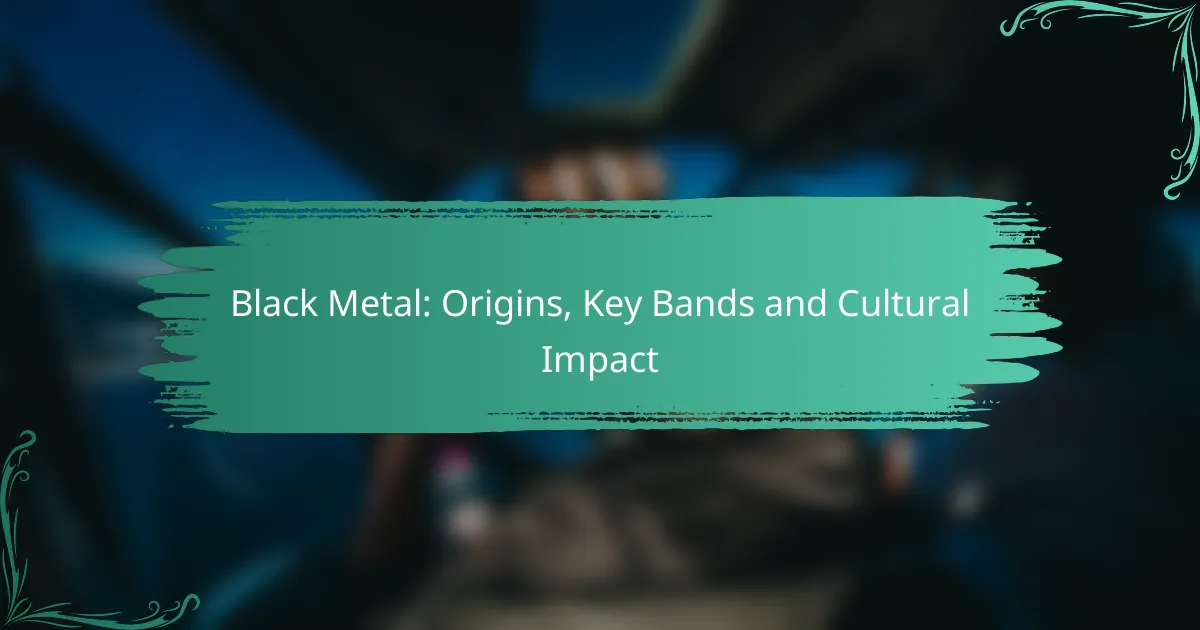Black metal emerged in the early 1980s as a distinct subgenre of heavy metal, known for its raw sound and dark themes. Influenced by thrash and speed metal, as well as punk rock and classical music, it has developed a unique and aggressive musical identity. Key bands like Mayhem, Burzum, Darkthrone, and Emperor have played pivotal roles in defining the genre, while its cultural impact extends to music, fashion, and art, resonating with themes of darkness and rebellion.

What are the origins of Black Metal?
Black metal originated in the early 1980s as a subgenre of heavy metal, characterized by its raw sound, dark themes, and often theatrical presentation. The genre emerged from a blend of earlier metal styles, particularly thrash and speed metal, with influences from punk rock and classical music, creating a unique and aggressive musical form.
Norwegian Black Metal scene
The Norwegian black metal scene, which gained prominence in the early 1990s, played a crucial role in defining the genre’s identity. Bands like Mayhem, Burzum, and Darkthrone brought a distinct sound and aesthetic, often incorporating themes of nihilism, anti-Christianity, and nature. This period was marked by a notorious reputation, including church burnings and violent incidents, which contributed to the genre’s mystique.
Norwegian black metal is also known for its lo-fi production quality, which enhances the rawness of the music. The use of corpse paint and elaborate stage performances became trademarks of the scene, creating a visual identity that resonated with fans.
Influence of early bands
Early bands such as Venom and Bathory laid the groundwork for black metal, influencing its sound and thematic elements. Venom’s 1982 album “Black Metal” is often credited with coining the term and establishing the genre’s dark, rebellious spirit. Bathory further developed the style, integrating Viking themes and a more melodic approach, which would later inspire many Norwegian bands.
The impact of these early pioneers is evident in the music of later bands, who adopted their aggressive guitar riffs, shrieking vocals, and atmospheric elements. This lineage helped shape the genre’s evolution and its global reach.
Key cultural movements
Black metal is intertwined with various cultural movements, including paganism, nationalism, and anti-establishment sentiments. Many bands draw inspiration from Norse mythology and folklore, reflecting a fascination with ancient traditions and a rejection of modernity. This connection to heritage is a significant aspect of the genre’s appeal.
Additionally, the genre has often been associated with a countercultural identity, challenging societal norms and mainstream music. This rebellious spirit resonates with fans who seek authenticity and a sense of belonging within the black metal community.

Which bands are essential to Black Metal?
Several bands are foundational to the black metal genre, each contributing unique sounds and philosophies. Key bands include Mayhem, Burzum, Darkthrone, and Emperor, which have shaped the genre’s identity and influence over the years.
Mayhem
Mayhem is often regarded as one of the pioneers of black metal, emerging from Norway in the early 1980s. Their music is characterized by raw production, aggressive guitar riffs, and haunting vocals, which set the tone for the genre. The band’s early work, particularly the album “De Mysteriis Dom Sathanas,” is considered a landmark release that defined the sound and aesthetic of black metal.
Mayhem’s history is also marked by controversy, including the tragic death of vocalist Per “Dead” Ohlin and the infamous actions of guitarist Euronymous. These events have contributed to the band’s mythos and the darker themes prevalent in black metal.
Burzum
Burzum, created by Varg Vikernes, is known for its atmospheric sound and minimalist approach to black metal. Vikernes’ work, particularly the self-titled album and “Filosofem,” showcases a blend of ambient music and traditional black metal elements, influencing countless artists. Burzum’s music often explores themes of nature, mythology, and personal introspection.
Vikernes’ controversial life, including his imprisonment for murder and arson, has overshadowed his music but also added to the allure of Burzum within the black metal community. Despite the controversies, Burzum remains a significant figure in the genre.
Darkthrone
Darkthrone is celebrated for its raw sound and DIY ethic, emerging from Norway’s black metal scene in the early 1990s. Their albums, such as “A Blaze in the Northern Sky” and “Transilvanian Hunger,” are essential listening for fans of the genre, featuring a blend of punk influences and traditional black metal aesthetics. Darkthrone’s music often incorporates themes of darkness, isolation, and the occult.
The band has evolved over the years, experimenting with different styles while maintaining their black metal roots. Their commitment to authenticity and independence has made them a respected name in the underground metal community.
Emperor
Emperor is known for its symphonic approach to black metal, combining intricate melodies with aggressive instrumentation. Their albums, particularly “In the Nightside Eclipse,” are hailed for their complexity and orchestral elements, setting a high standard within the genre. Emperor’s music often explores themes of darkness, mythology, and existentialism.
The band’s live performances are also notable for their theatricality, further enhancing their reputation as one of the leading black metal acts. Emperor’s influence can be seen in many modern black metal bands that seek to blend melody with intensity.

How has Black Metal influenced culture?
Black Metal has significantly influenced culture by shaping music, fashion, and art, while also leaving a mark on film and literature. Its themes of darkness, rebellion, and anti-establishment sentiments resonate across various creative expressions.
Impact on music genres
Black Metal has played a crucial role in the evolution of several music genres, particularly within the heavier spectrum of rock and metal. Subgenres like Death Metal, Doom Metal, and even Post-Rock have drawn inspiration from Black Metal’s aggressive sound and atmospheric elements.
Many bands incorporate Black Metal’s signature traits, such as blast beats and shrieking vocals, into their music, creating hybrid styles. For example, bands like Behemoth and Opeth have successfully blended Black Metal with other genres, expanding its reach and influence.
Influence on fashion and art
The aesthetic of Black Metal has profoundly impacted fashion and visual art, characterized by dark themes, corpse paint, and leather attire. This style often symbolizes rebellion against societal norms, appealing to those who resonate with its anti-establishment ethos.
Artists and designers have embraced Black Metal’s imagery in various forms, from album covers to streetwear. The use of dark colors, occult symbols, and gothic elements in fashion has become a staple, influencing trends beyond the music scene.
Black Metal in film and literature
Black Metal’s themes of darkness and existentialism have found their way into film and literature, inspiring works that explore similar motifs. Films like “Lords of Chaos” depict the controversial history of the genre, while literature often delves into themes of nihilism and rebellion.
Writers and filmmakers frequently draw from Black Metal’s rich symbolism and narratives, creating stories that reflect its cultural impact. This crossover continues to inspire new generations, ensuring that the essence of Black Metal remains relevant in contemporary media.

What are the key characteristics of Black Metal?
Black Metal is defined by its aggressive sound, dark themes, and distinct aesthetic. Key characteristics include fast tempos, shrieking vocals, and an emphasis on atmosphere, often drawing from themes of nihilism, nature, and the occult.
Musical elements
The musical elements of Black Metal are characterized by high-speed guitar riffs, blast beat drumming, and a raw production style. Guitars often utilize tremolo picking to create a wall of sound, while the bass may be less prominent in the mix. Vocals typically feature harsh, shrieking styles, contrasting with occasional clean singing or choral elements.
Many Black Metal bands incorporate atmospheric elements, such as keyboards or ambient sounds, to enhance the overall mood. This combination creates a sound that is both aggressive and immersive, appealing to listeners seeking intensity and depth.
Lyrical themes
Lyrical themes in Black Metal often explore darkness, anti-religion, and existentialism. Common subjects include nature, mythology, and personal struggles, reflecting a deep connection to the human experience and the natural world. Some bands also delve into historical or philosophical topics, adding layers of meaning to their music.
While many lyrics express a sense of nihilism or rebellion, others may celebrate beauty in darkness or critique societal norms. This diversity in themes allows for a wide range of interpretations and emotional responses from listeners.
Aesthetic and imagery
The aesthetic and imagery of Black Metal are crucial to its identity, often featuring dark, foreboding visuals. Band logos are typically intricate and stylized, while album covers may depict bleak landscapes, occult symbols, or mythological references. This visual aspect reinforces the music’s themes and creates a cohesive artistic vision.
Live performances often enhance this aesthetic, with bands using elaborate stage setups, costumes, and lighting to create an immersive experience. The overall imagery serves to evoke feelings of dread, mystery, and introspection, drawing fans deeper into the Black Metal culture.

How does Black Metal differ from other metal genres?
Black metal is characterized by its raw sound, atmospheric elements, and often dark, anti-establishment themes. Unlike other metal genres, it emphasizes a lo-fi production quality and incorporates elements of classical music, folklore, and ambient sounds to create a unique auditory experience.
Comparison with Death Metal
While both black metal and death metal share a heavy sound and aggressive vocals, they differ significantly in themes and musical structure. Death metal typically features complex song structures, technical instrumentation, and themes centered around death and violence, whereas black metal often focuses on nature, mythology, and existentialism.
Musically, black metal tends to have a more melodic approach with high-pitched shrieking vocals, while death metal is known for its guttural growls and intricate guitar riffs. This distinction creates a different emotional atmosphere in each genre.
Contrast with Thrash Metal
Thrash metal is faster and more rhythmically aggressive than black metal, often incorporating punk influences and socially conscious lyrics. Black metal, on the other hand, is generally slower, with a focus on creating an immersive, atmospheric experience rather than speed and aggression.
In terms of instrumentation, thrash metal features sharp, fast guitar riffs and energetic drumming, while black metal often employs tremolo picking and blast beats to evoke a sense of chaos and darkness. This fundamental difference in style leads to distinct listening experiences.
Unique subgenres within Black Metal
Black metal encompasses several unique subgenres, each with its own characteristics. For instance, atmospheric black metal emphasizes ambient soundscapes and often includes longer song lengths to create a meditative experience.
Other subgenres include symphonic black metal, which incorporates orchestral elements, and depressive black metal, focusing on themes of despair and hopelessness. These subgenres showcase the diversity within black metal while maintaining its core aesthetic and thematic elements.

What are the challenges faced by Black Metal artists?
Black Metal artists encounter various challenges, including societal backlash, censorship, and the struggle for authenticity within a niche genre. These obstacles can impact their creative expression and public reception.
Controversies and censorship
Controversies surrounding Black Metal often stem from its themes, imagery, and the actions of some artists, leading to significant censorship. For instance, certain lyrics and performances may provoke outrage, resulting in bans from venues or media platforms.
In some countries, particularly in Europe, laws regarding hate speech can complicate the promotion of Black Metal. Artists must navigate these regulations carefully to avoid legal repercussions while maintaining their artistic integrity.
Additionally, the genre’s association with extreme ideologies can lead to public misunderstanding. Artists may face challenges in distancing themselves from negative stereotypes while still embracing the darker aspects of their music.
